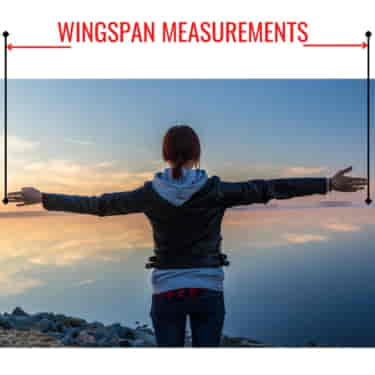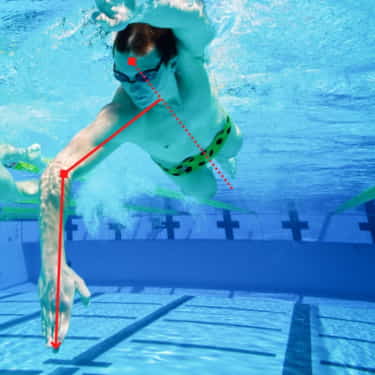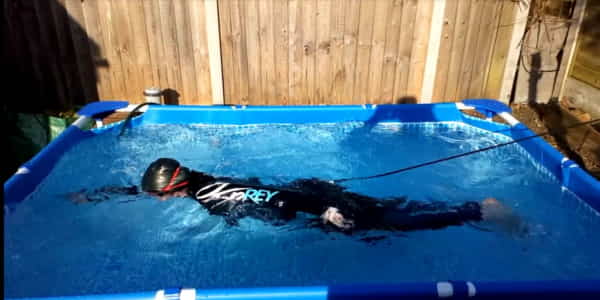During the 2020 lockdown, I missed my swimming pool sessions so much that I invested in an above-ground steel frame garden pool and a swimming harness so I could continue to swim at home in my garden.
My biggest concern was: Would the new pool be deep enough for me to train in?
As a general rule, most adult swimmers prefer a minimum depth of at least 3 feet (0.9 meters) and most standard pools in the UK will have a shallow end of at least 3 feet (0.9 meters), this is in accordance with Swim England guidelines.

However, it is possible to swim in shallower water with some learner pools in the UK sloping from 2 feet (0.6m) to 3 feet (0.9m).
I am 5ft, so I was lucky enough to need only the smallest steel frame pool with a water depth of just 2 feet (0.6m). However, even for my shorter size, this is only just comfortable.
When I move to a bigger garden, I plan to invest in the bigger pool size, which has a depth of 2.5 feet (0.75m) for a bit more comfort.
If you’d like more details about how I train in my above ground backyard pool, I’ve written an article covering the topic in much greater depth.
According to most reviews, as well as the swimmers I follow online who use a garden pool to train (including Olympic athletes), a depth of 2.5 feet (0.75m) is deep enough for them to train using freestyle swim stroke. However, their fingers touch the bottom of the pool on each stroke.
In this article, you will learn:
- How to Calculate the Minimum Water Depth You Need
- How to Calculate the Minimum Pool Length You Need
- How Different Training Requirements Impact Pool Size
How to Calculate the Minimum Water Depth You Need
When I invested in an above-ground steel frame garden pool, I became obsessed with establishing the absolute minimum water depth required for swimming freestyle.
It’s safe to assume that the deeper the steel frame garden pool you can afford, the better. However, space is often a limiting factor for many swimming enthusiasts and you may have to choose a smaller pool just because lack of space requires it.
My garden is so small, I didn’t have the luxury of buying the bigger pool ‘just to be on the safe side’. This meant that I might invest in a steel frame pool for my garden, only to find that I could not train in it. That would have been a swimming disaster!
I researched exactly how to calculate the absolute minimum water depth I would need to swim in, and you can use my findings to work out your requirements based on your unique measurements.
When considering the minimum pool depth for a garden pool, you need to consider:
- Your wingspan, which is the length across your chest, from the tip of the longest finger on each hand.
- Your body mass or weight.
1 Measuring Your Wingspan and Pool Depth
The following method is something I developed and tested to ensure my pool was deep enough. Using these measurements, I got my pool depth right the first time.
Step 1. Measure Your Wingspan.
This is the distance between the tips of your fingers and across your chest when you’ve stretched out your arms as wide as you can (you may need someone else to hold the tape!).

Step 2. Half Your Wingspan Measurement
During your swim stroke, you will fully extend your arm in the water for the “pull stroke”. This is the deepest point of your swim stroke and, therefore, tells us the depth of water you need to swim without hitting the bottom of the pool.
Assuming that you have extended your arm for the front crawl (see image below) the depth you need to swim unrestricted will be roughly half of your wingspan.
Here is an image to help explain. From this image, the swimmer will need a depth of water equal to the distance shown by the solid red line which is running down his arm, roughly equivalent to half of his full wingspan.

Of course, you may not swim like this. You might stretch your arm out further or bend your elbow more, but as a general rule of thumb, this is a helpful guide to give you a ballpark figure for the depth of water you will need.
Step 3. Add Some Extra Depth To Be On The Safe Side
How you swim and how heavy you are will affect the minimum amount of water you will need.
For example, if you roll fully onto your side when you swim, your arm will naturally go deeper into the water, requiring a greater depth.
If this happens, and you have not accounted for it, you will find your fingers touching the bottom of the pool, forcing you to adapt your swim stroke to compensate. This is not ideal.
It is difficult to know how much extra water depth to factor in, but from my experience, if you can add an extra 10cm or 4 inches, this would really help.
2 Consider Your Weight and Pool Depth
This is something that I have not seen talked about elsewhere, but if you are a tall and more muscular person, you will sink more in the water and you should factor this into your calculations.
I explore this issue in more depth in my article about buoyancy. But in a nutshell: heavier objects are less buoyant.
As a result, consider your weight when choosing your minimum swim depth and ensure you add a couple of extra inches to your swim depth to allow for your body to sink in the water.
I worked out the pool depth of my above-ground steel frame pool to match my wingspan, but I didn’t account for the fact that I would sink slightly in the water.
However, I noticed that when I wear a wetsuit (which gives me more buoyancy) or a flotation training device such as a pull buoy, the water depth is perfect. Just that little bit of extra buoyancy helps me float to the surface more and gives extra depth for my full freestyle stroke.
So, if you still find your fingers touching the bottom of your pool, then using a pull buoy between your legs to raise your body in the water will help.

How to Calculate the Minimum Pool Length You Need
It is pretty easy to work out the minimum length you need to swim freestyle.
To do this, lie flat on your stomach and reach your hands forward over your head to make yourself as tall as possible.
The measurement from the tips of your toes to the tips of your fingers is the minimum pool length that you need (again, you might need someone to help get the measurements right).
Personally, I add an extra 1 foot (0.3m) for additional clearance so you will definitely be able to extend fully and manoeuvre in your pool.
If you can, try to get a pool that is at least 2 feet (0.6m) longer than your total height (toe tips to fingertips). This would be more ideal, otherwise, your fingers will touch the side of the pool with each stroke.
Here is a picture of me at full extension in my garden pool. I just fit!
Minimum Depth of A Competition Pool, Learner Pool & Diving Pool
I found it interesting to know what the minimum depths are for a competition pool, a learner pool, and a diving pool.
Swimming in different depths of water will create different swimming experiences.
| Pool Type | Depth |
| Minimum Recommend Depth | 3 Feet / 0.9 Meter |
| Minimum Recommend Depth for Tumble Turns | 3.2 Feet / 1 Meter |
| Learner Pool Minimum Depth | 1.9 Feet to 3 Feet / 0.6 Meter to 0.9 Meter |
| Competition Pool Minimum Depth | 3.2 Feet / 1 Meter |
Conclusion
It is important to know the minimum depth you can swim in, whether you are going on holiday and want to know if you can train in the shallow hotel pool, or like me, you want to buy a steel frame garden pool and make it as compact as possible.
In general, a depth of 3 feet is a good rule of thumb as a minimum required depth. However, it is possible to swim in shallower water.
Remember to consider how long your arms are and how much room underneath the water you need by measuring your wingspan, and don’t forget to consider your weight and the type of training you’d like to do.
Happy Swimming!

